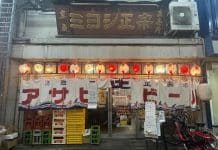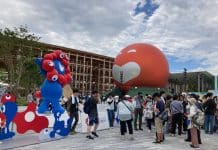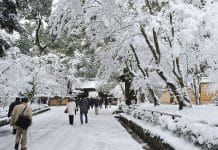Table of Contents
Introduction
Dirty, liars, fraudsters: these are the labels given to today’s tekiya, the street vendors with colorful yatai who brighten up Japanese festivals and markets. Paradoxically, it is often said that a matsuri without yatai is not a matsuri. So, in the face of prejudice, how do tekiya perceive their profession and how are they perceived?
It is 9:30 p.m. on July 9, 2025, at the Nishinomiya Shrine. The park is emptying as the Ara Ebisu festival, held in honor of the eponymous deity, comes to an end. While the deities are deeply rooted in the area, it is the itinerant merchants who capture my attention, those little hands without which the day of celebration would not have the same flavor. I am referring to the tekiya, the street vendors and their brightly colored stalls that are an integral part of Japan. During festivals, no matter how spectacular the ceremonies and religious rituals may be, it is the intensity of commercial exchanges that determines success for street vendors.

After putting away our sales equipment, Mr. T., a third-generation street vendor, insists on giving me a gift: a book published by a tekiya commercial cooperative in 1965. It is a rare collection of historical knowledge, due to its content and the street vendors who wrote it, in a context where it is difficult to obtain works produced by street vendors and where sources remain primarily oral. In the department, among all the families I have met, only Mr. T.’s family has it, and yet almost all of them have told me about it.
This book, written by tekiya of the time, traces the history of the corporation, provides a glossary of their slang, and is an essential archive for understanding how the groups functioned in the 1950s and 1960s. But more than that, it is a document that serves to perpetuate the nostalgic discourse that underpins the corporation, a text that recounts the past in order to keep it alive in the present.

The book is entitled Shinnō-do, “the way of divine agriculture,” in reference to their patron deity, Shinnō, the god of pharmacopoeia. If they are the only profession, along with pharmacists, to still pray to Shinnō today, it is because the tekiya are the descendants of the kōgushi or yashi, the “masters of incense instruments,” who appeared in the 17th century and once specialized in the sale of medicinal plants. Shinnō is not the only patron deity worshipped by this guild, but it is the one whose precepts they follow most fervently. Almost every family has a statuette of the god on their business premises.
The birth of the tekiya
In the 17th century, tekiya took over the sales territory represented by festivals. I have heard that there are “365 days a year of festivals” in Japan. The proliferation of matsuri festivals, the first of which is said to have been held in Kyoto in 862-863, contributed to the growing number of peddlers until the end of the 19th century.
Originally, street vendors set up shop in towns and along roadsides, specializing in the retail sale of everyday items of varying rarity, ranging from porcelain to children’s toys and street food. They then became itinerant in response to growing demand and because of the beneficial opportunities offered by peddling. These “mobile shopkeepers” are believed to be responsible for the democratization of street food in Japan.

Paradoxically, they have become an indispensable part of religious celebrations in both rural and urban areas, as well as secular celebrations such as municipal festivals. However, they themselves are considered deviants, dirty people. Tekiya were viewed as a pathological social group and were primarily studied from the perspective of “social pathology,” a sociological trend that was prevalent in Japan until the 1970s. Street vendors were portrayed in terms of their social and spatial marginality. From an organicist perspective, studies in social pathology approached human society as a living organism that could fall ill and needed to be treated. Crime, juvenile delinquency, suicide, prostitution, divorce, running away, alcoholism, drugs, gambling, and poverty were all elements of society considered pathological at the time.
The heirs of Shinnō-do
In the book Shinnō-do, from the very first sentence of the preamble, the author states that “in order to live a happy life and survive in today’s world, the key is to practice Shinnō-do” in these troubled times. Following Shinnō-do means behaving like a kyōkaku, a “chivalrous adventurer.” It also meant showing solidarity like “the five fingers of the hand” among members of the organization, but also with the local populations. As one of the authors, Kosaka Tokio, himself a street vendor, writes: “Being an ally of the weak and rebelling against the most corrupt is the philosophy of the person called Shinno-san, and the sacrificial spirit of not fearing death for the sake of others and justice is the spirit of those who follow this course of action.” In fact, many street vendor unions are named “[…] Shinnō-kai.” Shinnō remains an iconic figure to whom social scientists, like the tekiya, are not immune.

Although they are considered by the general public to be vectors of dirt, they want to stand out as men who enable society to be cleaned up, in a spirit of solidarity. As Kozaka Tokio, himself a tekiya, writes: “The trade of street vendors is part of social work and social infrastructure.” Today’s tekiya criticize their colleagues who stray from Shinnō-do and deviate from “ancestral values.” For the tekiya I have met, being Shinnō-san means above all respecting this code of honor, not failing the guild, and acting in mutual aid. For example, Mr. T. now recruits day laborers from among students in need or aikidokas in his neighborhood association. For him, brotherhood is paramount and helping young people is one of his missions. “They won’t become tekiya per se, they help us out from time to time, but it allows them to earn a little money to help them,” he explains.
Feudal tradition
Being a Shinnō-san, a disciple of Shinnō, also means continuing a tradition inherited from the feudal era in an ultra-liberal society, being a “modern-day knight” who comes to the aid of people in need. Street vendor groups disregarded the social origins of candidates, and the guild was often a refuge for marginalized populations. According to the tekiya, recruiting from the lower social classes is synonymous with their commitment, while reinforcing the prejudices held against them by the general public. In particular, they employed Korean immigrants and burakumin.
Tekiya and disasters
The implementation of these values is perfectly illustrated in the aftermath of the 1923 Kantō earthquake and in the post-war period, when the tekiya organized themselves to help victims and welcomed new members into their ranks to enable them to earn a decent living. After the war, street stalls played a crucial role in rebuilding the country. With limited ingredients and an urgent need to feed the population, mobile food stalls became a symbol of resilience.
More recently, another natural disaster joined the ranks of the tekiya: the 1995 Kobe earthquake. Some of the people surveyed remember this period: “We stopped the festivals to help the locals rebuild and feed themselves. We prepared food in the streets,” explains Mr. F., a sixth-generation tekiya in his family. My research does not currently allow me to say whether these demonstrations of solidarity had an impact on the image of tekiya among the Japanese. Nevertheless, apart from the 1995 earthquake, natural disasters are now too distant in time for the Japanese to talk about them.

To value the memory
At festivals, Mr. F., leader of a group from Kobe, is valued for his memory. “His grandfather was the head of the department’s cooperative,” Mr. T. tells me. “He knows a lot! “ Knowing and embodying family history is essential for tekiya. Since their history is primarily oral and very little has been recorded, current generations must memorize and, above all, communicate the knowledge of their elders. Discussions then turn to topics such as ancestry, the past, and age-old ”traditions,” which vendors happily share. Few photos and books have survived; oral tradition is paramount. That is why a book like Shinnō-do is so coveted.
The book is written in formal, old-fashioned Japanese, which is unusual in tekiya language. Few of the street vendors have graduated from school. And I can bet that few will read this book. But that’s not the point: holding a piece of their history in their hands gives credence to their words. It’s about appealing to a past order that founded a shared sociocultural identity.
Selling dreams and nostalgia
Nostalgia is an essential component of the discourse, but not only among merchants: the few works devoted to tekiya over the past fifty years advocate for the recognition of street vendors as a profession, defending their right to nostalgia and the authenticity they represent during matsuri festivals. Rather than being purely regressive, nostalgia functions as a performative register: it justifies the presence of stalls in the festive space, legitimizes ritual practices, and serves as a symbolic resource for generational transmission.
While it is common in my field to hear that “a matsuri without stalls is not a matsuri” and that they are essential for creating a festive atmosphere, authors often dedicate their works to the most renowned tekiya in the profession, recognizing both their talents as speakers and their legitimacy to perform during the festivities. For example, Sanbe Keishi’s book, whose title is evocative: Night Fairs, Selling Dreams and Nostalgia. Selling dreams and nostalgia, reconnecting with the “traditions” inherited from a feudal past, referring to them while appropriating them in another context: this is the mission of street vendors for these authors, who are restoring the reputation of peddlers, considered to be urban marginalized people par excellence.

Exploitation of nostalgia
The exploitation of nostalgia can also be found in the autobiographies of vendors such as Takasato Kyōko in My Family Ran a Street Vending Business (2023), which offers a biography of her family to guide future generations. Practical manuals based on the authors’ experiences also exist for those who wish to follow in their footsteps and become a tekiya who respects these traditions.
The works of social scientists, meanwhile, are plagued by nostalgia, punctuated with images of street vendors with their handcarts, their rickety stalls or goods spread out on the ground, even though this is no longer the reality today. But researchers are not the only ones to defend these representations: the tekiya themselves like to show me these images from the past, pointing out that the yashi of yesteryear are their ancestors and that they themselves still work in the tradition of Shinnō-do. Street vendors and researchers alike make this period a “time out of time,” a decontextualized time, characterized by “a timeless quality of the past that serves as a reference for nostalgic statements, regardless of their conformity with reality.”
Sakazuki and imagination
I myself succumbed to this form of anthropological imagination known as nostalgia as I became captivated by the stories told about the secret ceremonies of exchanging sakazuki sake cups. In September 2024, I had the opportunity to participate in a sakazuki ceremony in Hyōgo Prefecture, an event described by participants as exceptional due to its rarity, during which Mr. H. was inducted as the leader of a large group with the utmost respect for the stories told and passed down to forge a sense of shared (albeit illusory) group identity, cohesion, and long-term continuity. If we compare my account with those of other researchers who have collected the words of tekiya, we can say that this ceremony has changed little in the 20th century. The ceremony is conducted in formal, archaic Japanese, and the sequence of events is always the same.

I see this ceremony as more than just a way of renewing groups and alliances. It is about reactivating the narratives and collective memory that embellish and form part of our collective identity, because nostalgia has the effect of contributing to the construction of identities and their expressions. It is not so much a distortion of the past as a distortion of memory mixed with a “desire to restore the social order of the past.”
Giving in to nostalgia does not mean falsifying stories, but rather reinterpreting a bygone past in order to project oneself into the future. This nostalgia is not so much a desire to return to a previous state as it is a desire to recognize certain aspects of the past as a basis for renewal and satisfaction in the future. All these “traditions,” whether recounted or experienced, make it possible to update a narrative, that of a guild where the practice of walking is no longer relevant and because of which they need to redefine themselves. Nostalgia is therefore a reaction to the speed of change that the profession has undergone, a search for viable alternatives to the acceleration of historical time.
For more information:
Shrine Concessions Face Ruin Through Guilt By Association – Japan Today
Postcard from Tokyo: The Street Vendors are Back! – Time
Japanese Street Vendors: Rolling Straight Out of History – Sakura





















